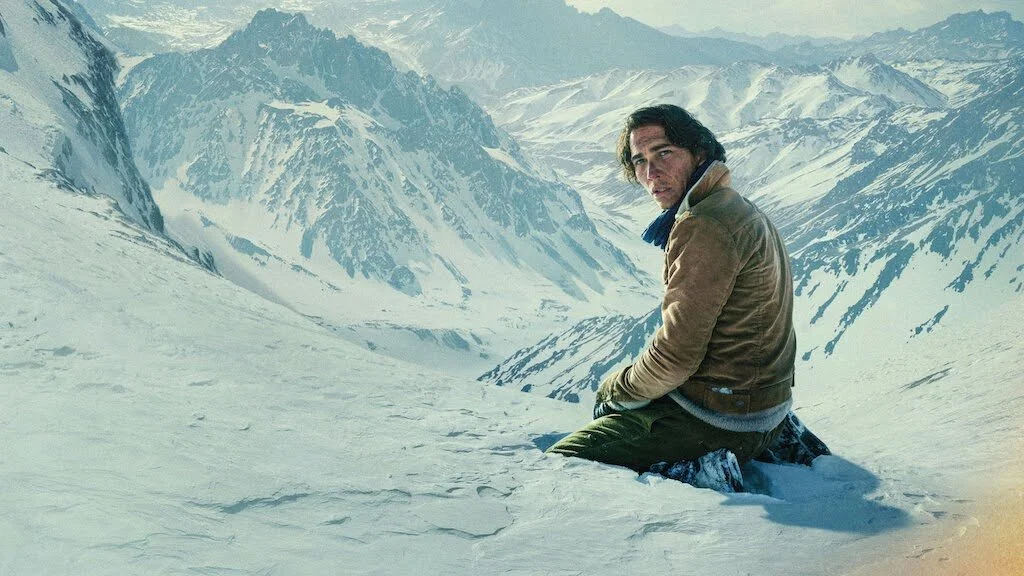Society of the Snow: The Crash Between Hope and Despair
by Laura MC
On Friday, October 13th of 1972, members of Uruguayan rugby team the Old Christians, along with some friends and family, expected to land in Santiago, Chile for a rugby match. From the 45 passengers of Flight 571 of the Uruguayan Air Forces, only 29 made it out alive after the plane crash-landed in the Andes Mountains between Argentina and Chile. Directed by Spanish filmmaker J.A. Bayona, Society of the Snow (2023) portrays what the 29 survivors endured during 72 days to make it out of the cold mountain range alive. The film is an ode to perseverance, hope, friendship, and most importantly, brotherhood.
In his previous projects such as The Impossible (2012) and A Monster Calls (2016), Bayona does an amazing job at adding that emotional, sensitive touch not just to the plot but to the characters. What he does with Society of the Snow is no exception. This film has plenty of characters (real passengers), and it’s already hard enough learning the names of all 45 of them. Despite this, Bayona does a brief yet brilliant job at introducing each of them to us. We don’t need a 10 minute sequence of everyone. Opening scenes such as the rugby match introduce us to the team players and, if you’re observant enough, along the film you start noticing how their traits and personalities develop before, during, and after the accident.
We are introduced to Numa Turcatti (Enzo Vogrincic) early on in the film. As a narrator of the story, he delves not only into what happened, but to whom. He tells us their struggles, their relationships with each other, and how each passenger did their part for all of them to survive. Although not a member of the rugby team, he was invited by his friends Gastón Costemalle (Jaime “Louta” James) and Pancho Delgado (Valentino Alonso). The fact that Numa started as a stranger, only to end up as one of the most important members of the team, is telling of his character and the impact he had on the survivors still alive to this day.
This brotherhood born from the plane crash is what warmed the survivors up and saved them from the cold. Medical students, as young as 21, took it upon themselves to help the injured. The youngest relied on the eldest and followed their orders to keep the environment safe and organized. They all depended on each other to keep hope alive, finding short moments of joy that almost made them (and me) forget they were stranded on a mountain range. In this society that the survivors built together, they trusted each other to be pulled out of the snow after an avalanche, they trusted Fito Strauch (Esteban Kukuriczka) to sort out the food, and they trusted Nando Parrado (Agustín Pardella) and Roberto Canessa (Matías Recalt) to get them out of that cold hell. It’s in moments like these where they show the audience “there is no greater love than that which gives one’s life for one’s friends.”
Bayona’s emphasis on their emotional bond only makes it more gut wrenching and heartbreaking once the number of survivors starts decreasing, going from 29 to the final 16. Although it’s basically impossible to get attached to all 29 of the first survivors, there’s a void that prevails throughout the film after more tragedies hit (as if the plane crashing wasn’t already tough enough). And it hurts.
Another film based on the same event, Alive (1993, Frank Marshall), was targeted to a more American audience. It had Ethan Hawke as the main lead, the addition of scenes that definitely did not happen in the Andes in order to make the story appear more dramatic, and what most Latin Americans consider the most disrespectful—changing the names of the deceased, therefore erasing their identity. Sharing what happened is one thing but in Bayona’s retelling, aided by the survivors and families of the deceased, he is able to narrate how it happened the way it did. It’s brutal; astounding. It can be seen in sequences such as the plane crashing, in the light of hope that soon vanishes when the survivors thought they would be rescued. One of my favorite scenes is when they make the hardest decision in order to survive: their answer to the dilemma of how they should be feeding themselves. You see them struggling, figuring out the legality of it, and most importantly, the morality behind it. Taking into consideration how religion plays a big part in the survivors’ life, it raises the question of how far your faith can save you. It just makes the entire debate as human as it is devastating. It makes you wonder, until what point can you reach in order to survive?
So the survivors find a source of energy to ease their hunger, but at what cost? The crash made them family, only to die in each others’ arms. These crashes between hope and despair might be too much to handle but they put things into perspective. In order to move on, you have to leave some things behind; for the survivors, that means leaving behind everything they knew back in Uruguay, and starting from scratch in order to stay alive. As Arturo Nogueira (Fernando Contigiani) tells Numa—unlearning in order to survive.
With this film, Bayona and his incredible cast and crew touched so many hearts—not just amongst the hispanic population, but the entire world. Society of the Snow received an Oscar nomination for Best Foreign Film and Best Makeup and Hairstyling, and it’s incredible how much it has been talked about in such a short time. The film had a short release time in cinemas in December of last year, but it can now be watched on Netflix and I genuinely encourage you to do so. All I ask is that you bring a box of tissues.






